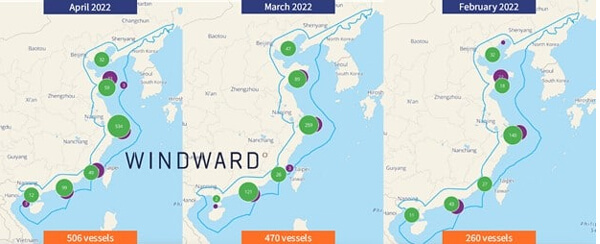Windward: Fifth of World’s Containerships are Stuck in Port Congestion
After signs of progress that the backlogs of containerships stacked up outside ports might be easing, it appears that the trend is reversing itself. With lockdowns impacting the movement of vessels at the major Chinese ports, the congestion appears to be spreading to other ports around the globe.
New data from Windward, the maritime AI company, shows that a fifth of all the world’s containerships are stuck in port congestion. Further, they calculate that a quarter of all the ships are specifically stuck at Chinese ports. Carriers have been struggling to manage their schedules which have already shown low reliability. Now, there are increasing reports of the number of containerships diverting away from Shanghai, but that is adding to the delays at other ports such as Ningbo-Zhoushan due to the added volumes, or carriers are resorting to blanked sailings.
The increases align with the lockdown in Shanghai that began at the end of March. Just before that, Sea-Intelligence reported the first improvement in schedule reliability in two years. While nearly two-thirds of all containerships were still behind schedule in February 2022, Sea-Intelligence’s monthly Global Liner Performance report highlighted that reliability returned to levels not experienced since mid-2021. Further, they reported that the number of days vessels were behind schedule while still high had also improved.
“The lockdowns in China are heavily impacting the congestion outside the country’s ports,” writes Windward based on data pulled for its Maritime AI platform and released on April 19. “The number of container vessels waiting outside of Chinese ports today is 195 percent higher than it was in February.”
Congestion off China's ports in the last three months from Windward's Maritime AI data
Windward uses three images each providing a 48-hour snapshot of container vessels waiting outside of China’s ports to illustrate their analysis. They compare February when there were no lockdowns in China to March when Shenzhen was in lockdown, and now April as the lockdown reached Shanghai a city of 25 million people and home to the world’s busiest container port.
“The trend is clear – in the April and March snapshots, there were 506 and 470 vessels, respectively, stuck outside of Chinese ports. In February, that number was only 260. In essence, lockdowns in China have nearly doubled the congestion outside the country’s ports,” concludes Windward.
Chinese officials continue to insist that the port of Shanghai is open and functioning. They point to the use of a closed-loop where port workers were placed inside a bubble separated from the city and people coming and going to the port. Truckers have been required for example to have negative COVID-19 tests to enter the port and truck traffic has been greatly reduced. Still, the ports are experiencing shortages of employees due to the spread of the virus.
While it would seem that with so many vessels stuck off China that other ports might be seeing relief, the opposite appears to be happening with schedules being disrupted for many of the major shipping routes. The Marine Exchange of Southern California’s data for example shows the number of container vessels again on the rise. On April 4, just as the lockdowns began in Shanghai, California reached a new low on its containership traffic with a total of 33 ships heading to Los Angeles and Long Beach. Today, by comparison, the Southern California backlog has jumped to 51 containerships, either near shore or steam toward the ports.
“When looking at the global picture, between April 12-13, 2022, 1,826 container vessels were waiting outside of ports worldwide,” reports Windward. “That’s 20 percent of all container vessels globally!”
Global port congestion from Windward's Maritime AI data
Windward’s Maritime AI data shows that 506 vessels are waiting offshore at China’s ports which represents more than a quarter (27.7 percent) of all the ships waiting outside of ports around the world. For comparison, in February, Windward calculates that the backlog off China’s ports accounted for about a sixth (14.8 percent) of the vessels stuck in port congestion worldwide.
Shanghai has begun to report some progress containing the recent wave of the virus and a decline in the number of daily cases. The health authorities have begun to relax some restrictions permitting factories to resume work using a closed-loop keeping workers onsite but it is unclear when the port can begin to regain its normal productivity. Even then there are fears of another ripple effect around the globe as shippers rush to move goods that have been stuck in the supply chain and carriers rush vessels to international ports seeking to restore disrupted schedules.


